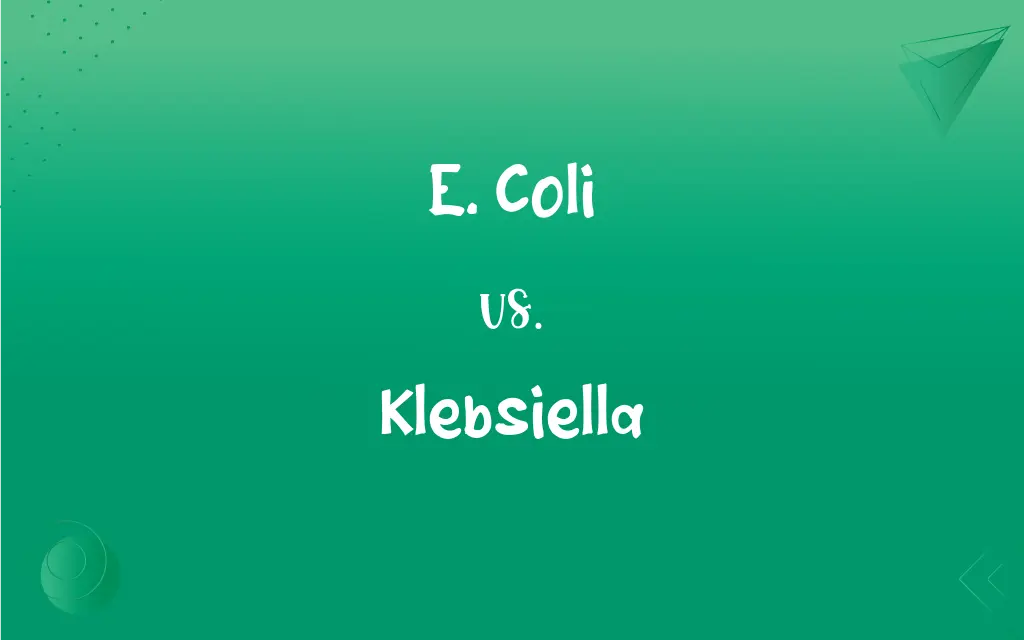E. Coli vs. Klebsiella: What's the Difference?
Edited by Janet White || By Harlon Moss || Updated on October 30, 2023
E. coli and Klebsiella are both gram-negative bacteria, but while E. coli is commonly found in the intestines, Klebsiella can be found in various environments including the human mouth.

Key Differences
E. coli, short for Escherichia coli, is a type of bacteria that is most often associated with the intestines of warm-blooded organisms, including humans. On the other hand, Klebsiella is a genus of bacteria that can be found in multiple environments, including the human mouth, intestines, and skin.
Most E. coli strains are harmless and are actually an important part of the gut flora in humans. They assist in breaking down food and absorbing nutrients. Conversely, Klebsiella species can be part of the normal flora but some strains can cause infections like pneumonia, bloodstream infections, and urinary tract infections.
E. coli has garnered significant attention due to certain strains that can cause foodborne illnesses. Ingesting contaminated food or water can lead to infections. Klebsiella, however, is especially known in healthcare settings, as it can cause hospital-acquired infections and is often resistant to multiple antibiotics.
Both E. coli and Klebsiella have been subjects of medical research due to their implications in human health. While E. coli is studied often for its roles in both beneficial gut health and foodborne outbreaks, Klebsiella is closely watched for its potential in antibiotic resistance and hospital-related infections.
Comparison Chart
Typical Habitat
Primarily in intestines of warm-blooded organisms
Various environments including mouth and intestines
ADVERTISEMENT
Known For
Some strains causing foodborne illnesses
Hospital-acquired infections
Disease Types
Diarrhea, urinary tract infections
Pneumonia, bloodstream infections
Resistance
Some strains show antibiotic resistance
Often resistant to multiple antibiotics
Beneficial Role
Assists in food breakdown in intestines
Some strains part of normal flora
E. Coli and Klebsiella Definitions
E. Coli
An indicator of fecal contamination in water.
The water sample tested positive for E. coli, suggesting contamination.
ADVERTISEMENT
Klebsiella
A type of bacteria known to cause healthcare-associated infections.
Hospital patients can be at risk of Klebsiella infections.
E. Coli
A bacterium used in research and biotechnology.
Scientists often use E. coli to produce proteins in the lab.
Klebsiella
A potential cause of pneumonia and urinary tract infections.
She was diagnosed with a Klebsiella-induced urinary tract infection.
E. Coli
A potential cause of foodborne illness.
Undercooked ground beef can be a source of E. coli contamination.
Klebsiella
A gram-negative bacteria found in various environments.
Klebsiella was isolated from the patient's wound.
E. Coli
A bacterium commonly found in the intestines of humans and other animals.
Proper cooking can kill harmful E. coli in food.
Klebsiella
Sometimes found as part of the normal human flora.
Not all Klebsiella are pathogenic; some live harmlessly in our mouths.
E. Coli
A gram-negative rod-shaped bacteria.
E. coli infections can lead to severe diarrhea.
Klebsiella
Known for antibiotic resistance in some strains.
The Klebsiella strain was resistant to multiple antibiotics.
Klebsiella
A nonmotile, gram-negative, rod-shaped bacterium of the genus Klebsiella, such as K. pneumoniae, that causes pneumonia and other infections usually in patients with diminished immunity, such as diabetics and alcoholics.
Klebsiella
Any of the genus Klebsiella of rod-shaped bacteria, which cause many diseases in humans.
Klebsiella
A genus of nonmotile rod-shaped gram-negative enterobacteria; some cause respiratory and other infections
FAQs
Can E. coli be harmful?
While most E. coli strains are harmless, some can cause foodborne illnesses.
What's the significance of E. coli in biotechnology?
E. coli is frequently used in labs for research and biotech applications, like protein production.
What is E. coli?
E. coli is a bacterium commonly found in the intestines of humans and other animals.
What infections can Klebsiella cause?
Klebsiella can cause infections like pneumonia, bloodstream infections, and urinary tract infections.
How does Klebsiella appear under a microscope?
Klebsiella is a gram-negative rod-shaped bacterium.
How can one get infected with E. coli?
Ingesting contaminated food or water is a common way to get an E. coli infection.
Why is Klebsiella a concern in hospitals?
Klebsiella is a concern due to its potential in causing hospital-acquired infections.
How can Klebsiella infections be prevented in healthcare settings?
Strict hygiene practices, including hand hygiene and disinfection, can help prevent its spread.
Is Klebsiella antibiotic-resistant?
Some Klebsiella strains are resistant to multiple antibiotics.
Are there beneficial strains of E. coli?
Yes, many E. coli strains are beneficial and play a role in gut health.
Can Klebsiella be found in healthy individuals?
Yes, some strains of Klebsiella are part of the normal flora in healthy individuals.
Are there vaccines for Klebsiella infections?
As of the last update, there isn't a widely available vaccine for Klebsiella infections.
Is E. coli always harmful in water?
The presence of E. coli in water suggests fecal contamination, which may contain other pathogens.
Is there a way to differentiate between E. coli and Klebsiella in a lab?
Yes, specific biochemical tests can differentiate between E. coli and Klebsiella species.
Can E. coli infections be prevented?
Proper food handling, cooking, and personal hygiene can prevent most E. coli infections.
Where is Klebsiella found?
Klebsiella can be found in various environments, including the human mouth, intestines, and skin.
How can E. coli contamination in water be identified?
E. coli presence in water indicates fecal contamination and is detected through testing.
Can E. coli be found outside the intestines?
While primarily in the intestines, E. coli can be found in other parts of the body and in the environment.
Can Klebsiella cause severe infections?
Yes, certain strains of Klebsiella can cause severe and sometimes life-threatening infections.
How is E. coli treated?
Treatment depends on the infection type, but antibiotics are often prescribed for pathogenic strains.
About Author
Written by
Harlon MossHarlon is a seasoned quality moderator and accomplished content writer for Difference Wiki. An alumnus of the prestigious University of California, he earned his degree in Computer Science. Leveraging his academic background, Harlon brings a meticulous and informed perspective to his work, ensuring content accuracy and excellence.
Edited by
Janet WhiteJanet White has been an esteemed writer and blogger for Difference Wiki. Holding a Master's degree in Science and Medical Journalism from the prestigious Boston University, she has consistently demonstrated her expertise and passion for her field. When she's not immersed in her work, Janet relishes her time exercising, delving into a good book, and cherishing moments with friends and family.































































